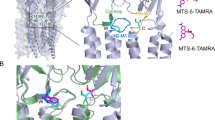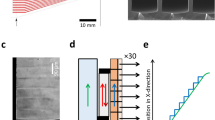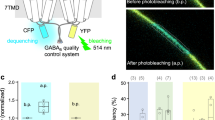Abstract
Drug-induced ionic channels are known to operate by opening briefly when agonist molecules bind to receptor sites1–7 to produce rectangular current pulses, the amplitude and lifetime of which can be derived from noise analysis1–3, or directly recorded using the patch-clamp technique4–7. If desensitization is neglected, the distributions of channel open and closed times can generally be fitted by single exponential functions5–7, suggesting that a simple two-stage reaction scheme is sufficient to account for the observed kinetics1. Using patch-clamp recording with an improved time resolution, we have now found that glutamate-activated channels in locust muscle membrane show a large excess of both brief openings and closings over those expected from single exponential distributions. Many events which, with poorer frequency resolution, would have appeared as single openings were found to consist of two or more openings, interspersed with brief (<300 µs) closings. These observations have interesting implications for receptor/channel functioning.
This is a preview of subscription content, access via your institution
Access options
Subscribe to this journal
Receive 51 print issues and online access
$199.00 per year
only $3.90 per issue
Buy this article
- Purchase on Springer Link
- Instant access to full article PDF
Prices may be subject to local taxes which are calculated during checkout
Similar content being viewed by others
References
Katz, B. & Miledi, R. J. Physiol., Lond. 224, 665–700 (1972).
Anderson, C. R. & Stevens, C. F. J. Physiol., Lond. 235, 655–692 (1973).
Anderson, C. R., Cull-Candy, S. G. & Miledi, R. J. Physiol., Lond. 282, 219–242 (1978).
Neher, E., Sakmann, B. & Steinbach, J. H. Pflügers Arch. ges. Physiol. 375, 219–228 (1978).
Patlak, J. B., Gration, K. A. F. & Usherwood, P. N. R. Nature 278, 643–645 (1979).
Cull-Candy, S. G., Miledi, R. & Parker, I. J. Physiol., Lond. 321, 195–210 (1981).
Sakmann, B., Patlak, J. & Neher, E. Nature 286, 71–73 (1980).
Colquhoun, D. & Sakmann, B. Nature 294, 464–466 (1981).
Dionne, V. E. J. Physiol., Lond. 310, 159–190 (1981).
Adams, P. R. J. Membrane Biol. 58, 161–174 (1981).
Neher, E. & Steinbach, J. H. J. Physiol., Lond. 277, 153–176 (1978).
Colquhoun, D. & Hawkes, A. G. Proc. R. Soc. B199, 231–262 (1977).
Colquhoun, D. & Hawkes, A. G. Proc. R. Soc. B211, 205–235 (1981).
Cull-Candy, S. G., Miledi, R. & Parker, I. J. Physiol., Lond. 317, 3–4P (1981).
Author information
Authors and Affiliations
Rights and permissions
About this article
Cite this article
Cull-Candy, S., Parker, I. Rapid kinetics of single glutamate-receptor channels. Nature 295, 410–412 (1982). https://doi.org/10.1038/295410a0
Received:
Accepted:
Issue Date:
DOI: https://doi.org/10.1038/295410a0
This article is cited by
-
Transport dynamics in a glutamate transporter homologue
Nature (2013)
-
Single glutamate-gated synaptic channels at the crayfish neuromuscular junction
Pflügers Archiv European Journal of Physiology (1987)
-
Electrical properties of ionic channels formed by Helix pomatia hemocyanin in planar lipid bilayers
Biophysics of Structure and Mechanism (1983)
Comments
By submitting a comment you agree to abide by our Terms and Community Guidelines. If you find something abusive or that does not comply with our terms or guidelines please flag it as inappropriate.



